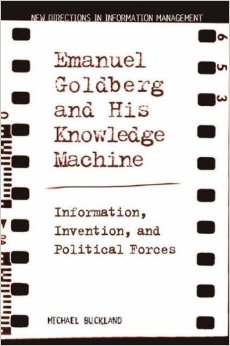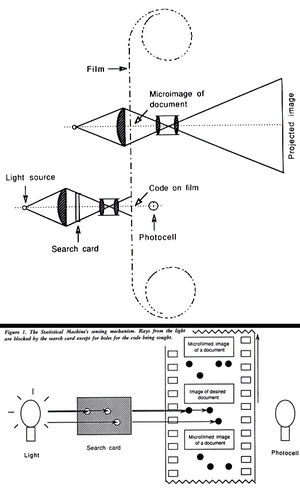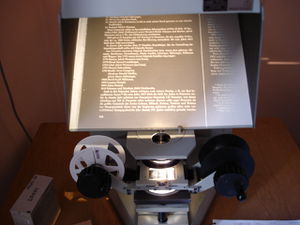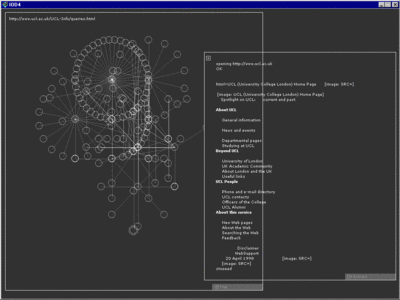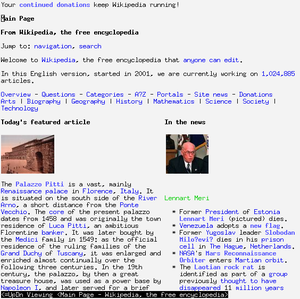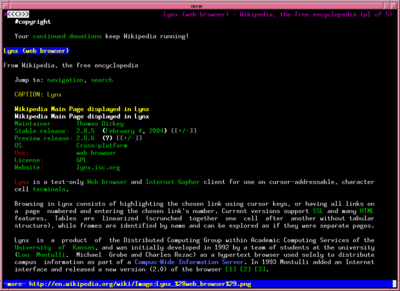User:Cristinac/tentativeobject
the browser
browse (v.) = mid-15c., "feed on buds," from Middle French brouster, from Old French broster "to sprout, bud," from brost "young shoot, twig," probably from Proto-Germanic *brust- "bud, shoot," from PIE *bhreus- "to swell, sprout"
Synonyms for browse:
look around look through flip through leaf through peruse read scan skim feed graze nibble survey check over dip into examine cursorily get the cream give the once over glance at hit the high spots inspect loosely once over lightly pass an eye over read here and there riff through riffle through run through skip through thumb through
>The browser< is ubiquitous software, it is a tool that is so essential to our online navigation habits, that it has mistakenly become synonymous with the internet (link to What is a browser?). It is a mass communication device that falls oftentimes in the background of our online interactions.
A browser is a retriever. It goes from point A to the indicated point B and collects the information that it can find at this location in order to return it to the user. Unlike a search engine, a browser requires specific knowledge of the destination's address. If we were to use an analogy to the library, a browser would be the librarian to which you would present the title of a book. The librarian searches through the entire collection and returns with the desired text.
>Retrieval systems<
By submitting a query consisting of information needs into a system, the user is asking it to fetch it. What is interesting to note is that in information retrieval theory a query does not uniquely identify a single object in the collection; instead, several objects may match the query, which leaves out the browser as a mechanism that requires exact input. As compared to search engines who employ crawling techniques, the browser makes the user leap towards the information he is looking for.
The communication between browser and human is facilitated through hyperlinks.
>As We May Think – Vannevar Bush<
>Physical Browser – Emanuel Goldberg's Statistical Machine<
Goldberg introduced his “Statistical Machine,” a document search engine that used photoelectric cells and pattern recognition to search the metadata on rolls of microfilmed documents. The machine would later be an inspiration for Bush's Memex – a device to hold all documents and records, a supplement to one's memory that could be easily accessed.
"In the photoelectric cell also an instrument is created which holds a host of currently unbounded possibilities for photographic recording. As one of these possibilities a new technique will be described here for the indexing [and retrieval] {zum Regustrierung} of any number of photographed documents. [...]
With the great number of items that come to be involved the retrieval of an individual image is in practice very difficult because on a normal spool — as used in movie equipment — up to 50,000 images would be stored.
This retrieval can now be achieved by mechanical means by which when photographing each individual document a statistical [i.e. numerical] description is recorded with it, which contains the document number (tax number, check number, customer’s account number) and, in addition, the day’s date. "
>What happens?<
- The browser sends an HTTP request through the internet to where the server that runs the website is located.
- The web server then sends back an HTTP response which is read by the browser to display the site.
- The response contains the website in HTML form, which the browser translates and displays the complete site as we view it.
- The HTTP request contains 3 parts:
the request line (includes command, web page requested and HTTP version number),
a request header (includes browser in use, date and some other info)
and the request body, which is optional.
- The HTTP response also consists of 3 parts:
the response status (HTTP version, status code and reason phrase),
the response header(optional info including server being used)
and the response body (the website in HTML).
>Web Directories<
"A web directory or link directory is a directory on the World Wide Web. It specializes in linking to other web sites and categorizing those links.
A web directory is not a search engine and does not display lists of web pages based on keywords; instead, it lists web sites by category and subcategory. Most web directory entries are also not found by web crawlers but by humans. The categorization is usually based on the whole web site rather than one page or a set of keywords, and sites are often limited to inclusion in only a few categories. Web directories often allow site owners to submit their site for inclusion, and have editors review submissions for fitness."
>Web Stalker<
"The Web Stalker is a software application for reading and manipulating information on the World Wide Web. It scans the hyperlinks on WWW-pages, displays their HTML code as the Web Stalker agent is analysing the pages, and maps the hyperlink structure in evocative graphics, allowing for a surprising look at the underside of the Web."
>Hermeneutics of Retrieval<
>Options: history, tools, bookmarks<
>Text-based browsers: Lynx, W3m<
>Yacy<
decentralized web search, P2P search
>Other alternative browsers<
>International Browser Day<
>the end of the browser?<
Browser wars no longer between same type navigation systems but between browsing and app-ing.

